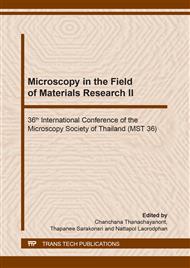p.79
p.85
p.93
p.101
p.107
p.115
p.123
p.135
p.141
Characterization of Mesoporous Silica and its Application as an Adsorbent for Benzene Sensing
Abstract:
Mesoporous silica (MPS) is a porous silica material with various pore structures. In this study, mesocellular foam silica (MCF) was synthesized and functionalized by hexamethyldisilazane (HMDS) to study effects of surface chemistry on benzene adsorption capability. Physical and chemical properties of pristine and functionalized MCFs were characterized and compared. Scanning and transmission electron microscopy showed that the complex pore structures of the MCFs were retained after the functionalization at relatively high temperature (573K). TGA and FTIR results showed that the functionalization led to a reduction of water adsorbed on the surfaces of the MCF. The functionalization improved adsorption of benzene compared to the pristine MCF and the optimum HMDS:SiO2 molar ratio was 1.5. The amount of benzene adsorbed has a linear relationship with the concentration of benzene in the environment. This relationship enables quantitative benzene detection by using the functionalized MCF as sensing materials in resistive-type or gravimetric-type benzene gas sensors.
Info:
Periodical:
Pages:
107-113
Citation:
Online since:
April 2020
Keywords:
Price:
Сopyright:
© 2020 Trans Tech Publications Ltd. All Rights Reserved
Share:
Citation:


